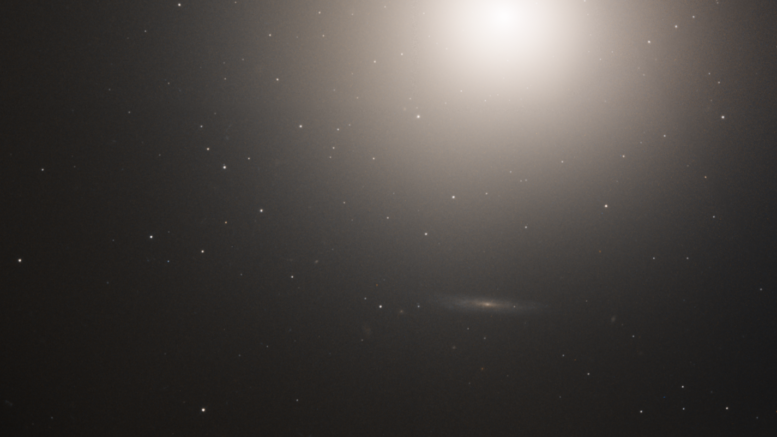Messier 89 (M89) is an elliptical galaxy located in the Virgo Cluster, in the constellation Virgo. Not as bright as some of the other galaxies in the Virgo Cluster, M89 is hard to see in a smaller telescope. Messier 89 was the first galaxy discovered to have an extended envelope. There is a central supermassive black hole in M89 that has an estimated mass of 1 billion solar masses.
| Description | |
| Visible From Pacific Northwest | February to May |
| Best Time To Observe | May |
| Minimum Size Of Viewing Device | Medium Sized Telescope |
| Object Type | Elliptical Galaxy |
| Designations | Messier 89, M89, NGC 4552, PGC 41968, UGC 7760, BWE 1233+1248, 2E 2786, 2E 1233.1+1249, 2MASX J12353988+1233217, MCG+02-32-149, RX J1235.6+1233, VCC 1632, VPC 1012, Z 70-184, Z 1233.1+1250 |
| Right Ascension | 12h 35m 39.8s |
| Declination | +12°33’23” |
| Constellation | Virgo |
| Number Of Stars | 100 billion |
| Apparent magnitude | +10.73 |
| Apparent dimensions | 5′.1 x 4′.7 |
| Object Radius | 40,000 light years |
| Distance From Earth | 50,000,000 light years (50 million) |
History
Messier 89 was discovered by Charles Messier on March 18, 1781, the same night he discovered and catalogued seven other members of the Virgo Cluster – Messier 84, Messier 86, Messier 87 (Virgo A) and Messier 90 located in Virgo constellationand Messier 85, Messier 88 and Messier 91 in Coma Berenices – as well as the globular cluster Messier 92 in Hercules. This is what Messier wrote about M89:
Nebula without star, in Virgo, a little of distance from & on the same parallel as the nebula reported above, No. 87. Its light was extremely faint & pale, & and it is not without difficulty that one can distinguish it.
John Herschel catalogued M89 as h 1348 and later included it in his General Catalogue as GC 3097, describing the object as “pretty bright; pretty small; round; gradually much brighter toward the middle.”
Locating M89 In The Sky
Messier 89 is positioned just south of the border between Virgo and Coma Berenices, about 60 percent of the way from the bright star Denebola in Leo to Vindemiatrix in Virgo. The galaxy can be found about 2 degrees west of the star Rho Virginis. It lies only 0.75 degrees southwest of the slightly brighter spiral Messier 90 and 1 degree northwest of the barred spiral Messier 58. The giant elliptical galaxy Messier 87 is only about a degree west of M89.

Viewing M89
It is not as bright as some other Virgo Cluster members in the vicinity and can be difficult to make out in small telescopes. In 8-inch telescopes, the galaxy appears as a faint ball of light, with only about half its apparent size visible. The best time of year to observe M89 is during the spring.
Photographing M89
Finding some great guides for imaging Messier 89 is really tough as the guides and information is few and far between. Making sure guidance done properly will help make sure that the image is crisp as the need for hours upon hours of exposure is not necessarily required for Messier 89.
http://www.astro-pat.com/MessierList/M89-030308.htm
Sources And Further Reading
Descriptions of all of Messier Objects can be found here.
https://www.nasa.gov/feature/goddard/2018/messier-89
https://freestarcharts.com/messier-89

Be the first to comment on "Messier 89"